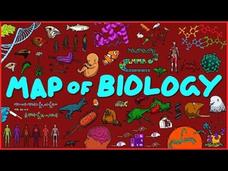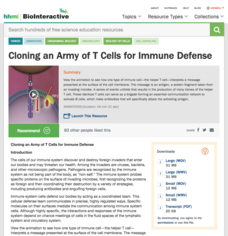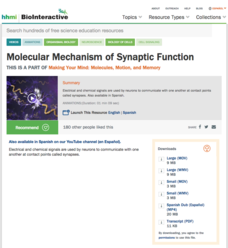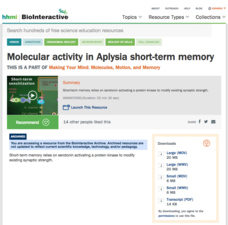Domain of Science
The Map of Biology
Many define biology as the study of life but can't agree on a definition of life. Trying to explain all of the domains and subdomains of biology seems a bit easier than defining life. See a full map of the topics covered by the general...
TED-Ed
What Is the Biggest Single-Celled Organism?
Meet Caulerpa taxifolia, believed to be the largest single-celled organism in the world. How does it work and where is it found? Learn all about this invasive algae and why it is so successful.
Howard Hughes Medical Institute
Cloning an Army of T Cells for Immune Defense
How do bodies fight infections and illnesses? An animation of the way T cells clone to fight an infection provides many details. The resource also provides an excellent written introduction and ideas for how to ensure pupils understand...
Howard Hughes Medical Institute
Molecular Basis of Late Ltp (Long-Term Memory)
Scholars compare and contrast the molecular changes for short-term and long term-memory with the help of animated videos. Viewers see the chemical process that changes the brain and stores memories thanks to dopamine.
Howard Hughes Medical Institute
Molecular Basis of Early Ltp (Short-Term Memory)
Digital amnesia: forgetting information one easily finds online. Learn how our brains move information into short-term memory at the molecular level with a short animation sure to make a memorable impression. Viewers observe a...
Howard Hughes Medical Institute
The Mammalian Molecular Clock Model
Animals don't read clocks, so how do they know when it is time for eating, sleeping, and other cyclical needs? Viewers watch an animation of the genes and the molecular clocks inside most mammals. They compare the difference in wild...
TED-Ed
How Plants Tell Time
Can someone really have a "biological clock"? Discover why many organisms on earth have an inherent awareness of where they are in the day's cycle.This video discusses animal adaptations, the earth's revolutions, and how light and...
Howard Hughes Medical Institute
Molecular Mechanism of Synaptic Function
Neurons don't touch each other, but they still communicate. Observe the process of both electrical and chemical signals used by neurons to share information. Hear exactly what triggers each step of the reaction as you view an animation...
PBS
How Two Microbes Changed History
Where would we be without bacteria? As it turns out, we owe them everything! Introduce young biologists to endosymbiotic theory using an amazing video from an extensive biology playlist. Scholars discover the bacteria that may be...
Curated OER
Anatomy of a Muscle Cell
Previous videos have dealt with the proteins that produce mechanical motion and how nerves stimulate contraction. But this presentation explains on a gross anatomical scale, how skeletal muscle is structured.
Curated OER
Human Genome
Welcome to the complex biological story that is our life. Great visual imagery zooms in on the dissection of a DNA double helix in our body. What happens with RNA? Where do amino acids come in? This resource explores our inner workings...
Howard Hughes Medical Institute
Molecular Activity in Aplysia Short-Term Memory
Scientists have yet to find the limit on the human brain's capacity for memory storage, so the potential is limitless! An animated video demonstrates how the brain places information in short-term memory. Viewers observe the...
Socratica
What Is Biochemistry?
Watch as chemistry comes alive! Socratica's biology playlist kicks off with a simple video detailing the principle components of biochemistry. Content includes carbohydrates, proteins, and nucleic acids. The narrator describes each class...
PBS
When Insects First Flew
Insects developed wings and the ability to fly earlier than any other animal—when exactly did that happen? Scientists know this fact but struggle to explain when insect wings developed and how this entirely new structure appeared. PBS...
Howard Hughes Medical Institute
Repellant Ephrin Signals Guide Limb Innervations
The foot bone connects to the leg bone, but how? Learn about how neurons grow in the proper direction thanks to signalling. Observe what happens when they encounter a repulsive ephrin signal and the correction process that takes place.
Howard Hughes Medical Institute
Neurons in Parietal Cortex Are Active During Straddling
How do scientists know which parts of the brain various functions use? With the help of an animated cat, viewers observe this process. They listen to the activity of one neuron as the cat steps over an obstacle and hear when the neuron...
Howard Hughes Medical Institute
Measuring Circadian Activity in Drosophila
How many hours should be in a day? One species of drosophila naturally prefers a 24.5 hour day, while another strongly prefers a 19-hour day. An animation and graph share data from each of these species when exposed to the typical light...
Other
Molecular Movies: Cell & Molecular Animation Showcase
An organized directory showcasing cell and molecular animations for use in high school biology classrooms.
TED Talks
Ted: Ted Talks: David Bolinksky Animates a Cell
View this video that contains 3 minutes of amazing cel animation created by David Bolinsky. In the video he discusses the project that was designed for the Molecular and Cellular Biology Department at Harvard. Included is a complete...
Khan Academy
Khan Academy: Cell Division: Embryonic Stem Cells
A video explaining embryonic and somatic stem cells by overviewing early development of an embryo. Also discussed is the reasons why embryonic stem cell research can be controversially. [19:54]
Khan Academy
Khan Academy: Cell Division: The Cell Cycle and Mitosis: Interphase
Learn about what happens to the cell during interphase in this video. Video will review how the cell prepares for cell division including chromosome changes, centromeres, and many more. [8:27]
Khan Academy
Khan Academy: Zygote Differentiating Into Somatic and Germ Cells
In this video tutorial, you will learn how a zygote, the single cell produced by fertilization, divides by mitosis to produce all the tissues of the human body. [9:35]
Khan Academy
Khan Academy: Cell Division: Meiosis: Comparing Mitosis and Meiosis
A video discussing the similarities and differences between the processes of mitosis and meiosis. Learn how mitosis results in two identical diploid cell while meiosis results in four haploid genetically different cells. [5:50]
Khan Academy
Khan Academy: Apoptosis
Video lecture provides a discussion on apoptosis (programed cell death) and how it is different from cell death by injury. Also, delves into its role in development and body maintenance. [10:47]

























